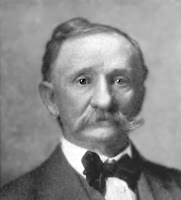| Image may be NSFW. Clik here to view.  |
| Timothy Regan. J. H. Hawley photo. |
John Regan attended Boise schools and then graduated “maxima cum laude” from Santa Clara College in California. Upon his return to Boise, he entered a lower position in Timothy Regan’s holdings. He also joined in the various social, athletic, and charitable endeavors expected for the son of a wealthy and influential Boise leader. There, he was apparently popular and well liked.
| Image may be NSFW. Clik here to view.  |
| John Regan. J. H. Hawley photo. |
He also enrolled, as a private, in the Idaho National Guard, but his impressive educational credentials soon brought officer’s rank. Despite some organizational complications, Regan was part of the Guard unit when it was merged into the Army's 116th Engineering Regiment for service in World War I. The unit sailed for France in 1918.
There, Regan requested, and was granted a transfer to a front-line unit. He joined the 128th Infantry Regiment, 32nd Division, composed of nationalized Guard units from Wisconsin and Michigan. Toward the end of July, the Division was ordered into the counter-attack meant to decide the Second Battle of the Marne. By then, French and American forces had begun to reduce the German salient, despite fierce resistance.
On the 31st, regiments of the 32nd Division advanced through and around the village of Cierges (located 60-65 miles northeast of Paris). Their objective on August 1 was “Hill 230.” Two regiments attacked the hill itself while the 128th assaulted Bellevue Farm, which anchored the German’s defensive line. The attack captured Hill 230, but Lt. Regan was hit clearing the Bellevue Farm defenses.
| Image may be NSFW. Clik here to view.  |
| 32nd Division soldiers assembling for attack, August 1, 1918. U. S. Army Signal Corps photograph. |
The medal citation read, “The Distinguished Service Cross is presented to John M. Regan, Second Lieutenant, U.S. Army, for extraordinary heroism in action near Cierges, France, August 1, 1918. Mortally wounded by enemy fire while leading his platoon, Second Lieutenant Regan remained at the head of his men till he collapsed. He set an example of coolness and fortitude to his command, encouraging them by word and action.”
The posthumous biography in Hawley’s History noted that during the service for Lt. Regan at the Cathedral of St. John the Evangelist, “for the first time a gold star was placed among the one hundred and twenty blue stars of the service flag of the parish.”
Hawley also wrote, “The Ada county post of the World War Veterans has been named the John M. Regan Post in his honor.” John’s remains were repatriated and interred in the family plot in Boise. American Legion “John Regan Post 2” honors his sacrifice each Memorial Day.
| References: [Hawley] |
| The 32nd Division in the World War I, 1917-1919, Wisconsin War History Commission, Madison (1920). |
